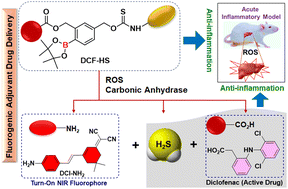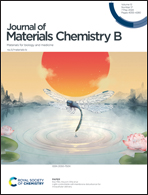Inflammatory-stimuli-responsive turn-on NIR fluorogenic theranostic prodrug: adjuvant delivery of diclofenac and hydrogen sulfide attenuates acute inflammatory disorders†
Abstract
Prolonged use of very commonly prescribed non-steroidal anti-inflammatory drugs (NSAIDs) is often associated with undesired side effects, including gastrointestinal ulcers due to the non-selective inhibition of cyclooxygenases. We describe the development of an inflammatory-stimuli-responsive turn-on fluorogenic theranostic prodrug DCF-HS for adjuvant drug delivery. Upon activation by reactive oxygen species (ROS), the prodrug releases diclofenac DCF (active drug) and the NIR fluorophore DCI-NH2 along with carbonyl sulfide (COS). The second activation of COS by the enzyme carbonic anhydrase (CA) generates hydrogen sulfide (H2S). The prodrug was conveniently synthesized using multi-step organic synthesis. The UV-Vis and fluorescence studies revealed the selective reactivity of DCF-HS towards ROS such as H2O2 in the aqueous phase and the desired uncaging of the drug DCF with turn-on NIR fluorescent reporter under physiological conditions. Furthermore, the release of fluorophore DCI-NH2 and drug DCF was confirmed using the reverse phase HPLC method. Compatibility of prodrug activation was studied next in the cellular medium. The prodrug DCF-HS was non-toxic in a representative cancer cell line (HeLa) and a macrophage cell line (RAW 264.7) up to 100 μM concentration, indicating its biocompatibility. The intracellular ROS-mediated activation of the prodrug with the release of NIR dye DCI-NH2 and H2S was investigated in HeLa cells using the H2S-selective probe WSP2. The anti-inflammatory activity of the active drug DCF from the prodrug DCF-HS was studied in the lipopolysaccharide (LPS)-induced macrophage cell line and compared to that of the parent drug DCF using western blot analysis and it was found that the active drug resulted in pronounced inhibition of COX-2 in a dose-dependent manner. Finally, the anti-inflammatory potential of the prodrug and the turn-on fluorescence were validated in the inflammation-induced Wister rat models.



 Please wait while we load your content...
Please wait while we load your content...